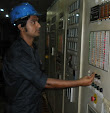Light Emitting Diode(LED)
A light emitting diode is a diode that gives off visible light when forward biased.
 |
| LED (image from wikipidea) |
Working Principle
 |
| Electronic Symbol |
In the Germanium and silicon diodes, almost the entire energy is gives up in the form of heat and emitted light is insignificant.However in materials like gallium arsenide, the number of photons of light energy is sufficient to produce quite intense visible light.
LED Voltage and Current
The forward voltage rating of most LEDs is from 1V to 3V and forward current rating range from 20mA to 100mA.In order that current through the LED does not exceed the safe, a resistor Rs is connected in series.
The voltage input is Vs and voltage accross LED is Vd
Then voltage accress Rs=Vs-Vd
Circuit current If=(Vs-Vd)/Rs
Application of LED
 |
| LED as power indicator |
 | ||
| LED used in seven segment display |
" Do not use LED in Parallel"








